Early Australian Currency
By AG | Monday, 15 September 2003
The First Fleet
The settlement of Australia by Europeans began with the departure of the First Fleet from England in 1787. The fleet was bound for Botany Bay, far off in the Southern Hemisphere, with a pathetic cargo of convicts. The east coast of New South Wales was regarded as a convenient dumping ground for convicts, now that the independent Americans had successfully rid themselves of English dominance.
New South Wales, as the eastern shore of the island continent was named by Captain Cook, would become a prison colony to which the unwanted criminal elements of Great Britain could be transported with no hope of escape.
The English Government provided none of the normal implements of commerce and trade, such as coins and banknotes. This was a time of severe currency shortage in the United Kingdom, with tradesmen's tokens, countermarked coins, bank tokens and other money of necessity circulating freely. No coinage was available to England's colonies. Officials of the new colony would be paid in produce from the company store and even free citizens would have little need of money.
When Captain Arthur Phillip, Governor of the new settlement, arrived in Sydney Cove in 1788 with eleven ships and 1,487 people, including 759 convicts, the small colony was virtually penniless. Apart from 300 pounds in currency held by the Governor, the only coins available were those carried in the pockets and purses of the passengers. It was not forseen that the small colony would almost starve to death because of drought, poor soil and various other problems which made it impossible for the settlement to become self-sufficient.
The first fleet brought sufficient provisions, with careful rationing, to keep its passengers alive for only two years. Their survival relied on the ability of the convicts to work the land and harvest crops. However, no-one had made allowances for the lack of farming experience, the unfamiliar soils or the harsh climate they found.
The first year's crop failed and most of the next year's harvest was required to replenish seed stocks. Draft animals and proper farming equipment were not available - it was more than 15 years before a plough was used in the colony. For the first five years the colony lived on the edge of starvation. The prolonged drought forced Phillip to spend some of his hoard of pounds to obtain supplies from Cape Town.
In 1792 the rain finally came and a successful harvest enabled the colony to become self sufficient in food production. In an ironic twist, it was only after this that trading ships from distant lands began to arrive, bringing with them the colony's first 'consumer goods' - clothing, boots, butter, tea and rum. The colonists now required some form of currency to pay the traders for the goods delivered. Attempts to induce the ships' captains to accept promissory notes (which could only be redeemed on the next visit to England), failed as they wanted cash to buy fresh cargos on the way.
The colonial authorities back in England had no inclination to send coinage to the settlement, knowing full well that it would be immediately spent on trade goods and disappear out of the colony within weeks of its arrival. Australia had a balance of payments problem from the very start.
Cut Dollars
The practice of cutting Spanish dollars into smaller segments to provide a fractional currency was a well accepted practice in many countries by the time the colony was established at Sydney Cove. The practice led to the famous term 'pieces of eight', where the original coin was quartered, and then each quarter segment was halved, leaving eight, approximately equal, pieces. The American term 'two bits', is derived from two of these pieces being equal to quarter of a dollar or 25 cents.
An interesting variation on this process occurred in the early NSW colony. The original Spanish dollar was quartered, often with a vertical and horizontal centre strip being removed and placed aside as illegally obtained profit for the fabricator. Each quarter segment was then cut into two pieces - a 2/3 segment and a 1/3 segment - producing eight pieces.
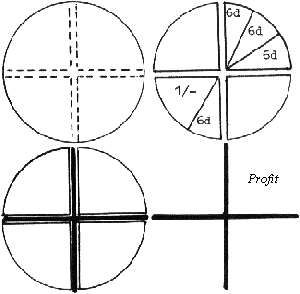
The larger segments became shillings while the smaller segments became sixpences - a nominal total value of 6 shillings. In practice, the shilling segments, or two sixpenny segments, could be used to purchase only ten pence worth of goods or services - leaving a purchasing power approximately equal to the 5 shillings of the original coin.
While occassional references to change being given in 'small triangular pieces of silver' are found in various records from the colony dated in the 1790's and into the early 1800's, these pieces played only a miniscule role as a medium of exchange .
Exiled Irish patriot Joseph Holt recorded in the early 1800's that on offering a guinea for a bottle of rum, he was given in change "three small pieces of silver of a triangular shape, the value of which I did not know". These were likely to have been parts of a dollar cut as described above. The ease with which cut dollar pieces could be reproduced today from real Spanish dollars has relegated them to curiosity status for most numismatists.
With little circulating money, other means of trade sprang up. People bartered for goods and services with anything that came to hand. Quite naturally, food stuffs - particularly rum, flour, pork, tobacco and tea - became the circulating medium. In 1796, a seat in Sydney's first theatre could be bought for a shillings worth of meat, spirits or flour. With necessity came invention and the next few years provide an extremely interesting period in Australia's numismatic history.
The three most prominent mediums of exchange in this cruicial 25 year period from the early 1790's until the arrival of Governor Macquarie in the second decade of the new century were Promissory Notes and I.O.U's., Governor King's Proclamation Coins including Boulton's Cartwheel coinage and goods, more particularly, the Rum Trade.
Promissory Notes and I.O.U's.
Officially, prices in the colony were in Pounds, Shillings and Pence (Sterling) but the only notes with Sterling value were Government Bills of Exchange on the British Treasury, Commissariat Store Receipts and Paymaster's Notes issued to the New South Wales Corps - the regiment of soldiers which arrived with the second fleet to maintain law and order and to run the general administration. The paymaster's notes were preferred and carried premiums as high as 25 percent over copper cash, and more over personal promissory notes or I.O.U's.
A number of stores and merchants issued private promissory notes, which took on the role of a circulating currency, however government regulation was clearly needed to stop unscrupulous traders from issuing worthless notes with no monetary backing. The story goes that a prominent publican was known to bake his notes in an oven before their issue to render them brittle.
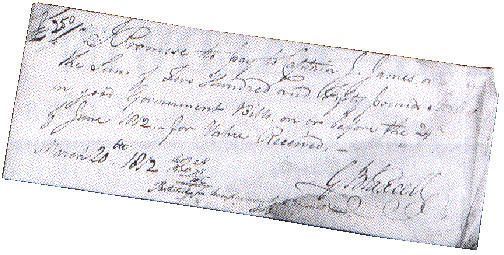
Easily forged, promissory notes were an extremely unreliable means of exchange. Their value was often contested. One notable case involved the future pioneer of the Australian wool industry and notorious officer of the New South Wales Corps, John Macarthur.
Prior to the 1806 floods, Macarthur accepted a promissory note from Andrew Thompson, farm bailiff to the newly arrived governor of the colony, William Bligh. The note was for a sum, stated in bushels of wheat at pre-flood prices. After the flood, wheat prices rose sharply. When Macarthur called up the note, Thompson tendered the quantity of wheat based on post-flood prices.
Macarthur sued, claiming the exact number of bushels expressed on the face of the note, irrespective of value. The court decided that the note was an expression of value, not quantity. Macarthur took the decision as a personal affront, setting in motion a chain of events which would eventually undermine Bligh's standing as Governor and see him ousted in the Rum Rebellion.
Even more remote than the isolated colony at Sydney Cove, the traders in Tasmania - Van Diemen's Land as it was then known - faced a cronic shortage of coins and banknotes. This led to a profusion of private promissory notes. See the separate article on Tasmanian Promissory Notes.
Private and Government notes were used as the exchange medium for the majority of transactions in the first decades of the colony. They were, in reality, the equivalent of our present day banknotes. See the separate article for a more detailed account of the issue and use of Paper Money in Early New South Wales. The use of paper for smaller denomination transactions was curtailed with the introduction of holey dollars, dumps and an increasing supply of copper coinage after 1814.
Proclamation Coins
Within 3 years of the establishment of the colony, disputes began to emerge over the value of the coins circulating, particularly the Spanish dollar. To clarify the situation, Governor Phillip issued the first proclamation concerning mediums of exchange in 1791 when he fixed the value of the Spanish Dollar at five shillings.
By 1800, the population of the colony had passed 5,000. A crazy collection of currencies including guineas, guilders, johannas, mohurs, rupees, Spanish dollars and ducats and Matthew Boulton's copper 'cartwheel' twopences and pennies had been left behind by visiting ships and were circulating in the settlement.
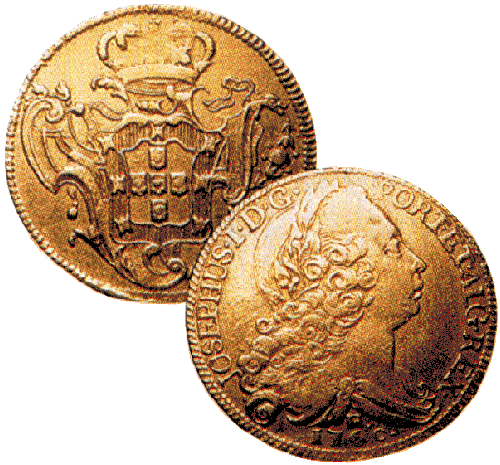
Governor Philip Gidley King, was determined to sort out the economic shambles of the colony. Guilders from Holland shared the same purse or pocket as pagodas from India, dollars from Spain or johannas from Portugal. These coins circulated at values related to their metal content. The values were continually disputed and even this small supply of coin was continually being syphoned off by the visiting traders.
King became the first to play an important role in Australian numismatics when he handed down his historic proclamation on 19th November, 1800. The proclamation was designed to give the wide range of coins circulating at that time official values which were high enough to keep them in the colony. In particular, the value of an English copper penny was proclaimed at double its nominal value. The rationale was that few traders would want them at their inflated value. He only partly succeeded.
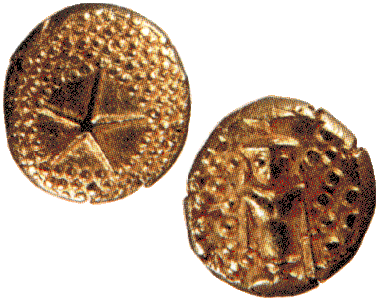
While the colony now had a standard from which to trade, by raising the value of the coins, ( and making a tidy profit) King's proclamation had tampered with inflation. The proclamation failed to keep the coinage in the colony as visiting sea captains simply increased their prices accordingly.
The proclamation also resulted in a rather derogatory term being 'coined' for the colonials: 'Currency lads and lasses' was an expression of inferiority. Its double-edged meaning was that people from the colony were not as good as the English-born product, just as the colonial currency was not worth as much as the English sterling currency.
There is some dispute in modern numismatic circles over both the importance placed on the 1800 proclamation in resolving the circulating coinage problems, and on the coins that were actually meant to be covered. Purists believe that only those coins specifically mentioned in the proclamation deserve the label 'Proclamation Coin', while others, particularly dealers looking to mark up the value of their offering, believe that by default, the multiples and fractions of coins specifically mentioned gained a valuation and should also be included in the definition.
The 'Cartwheel' Pennies
Big, ugly and heavy, Australia's first official coins - the 'Cartwheel' pennies - were not received enthusiastically. Historically, however, they are magnificent. They were the first coins officially exported to the colonies and included the first copper pennies ever struck in England. They were also the first English coins to be struck using steam power.
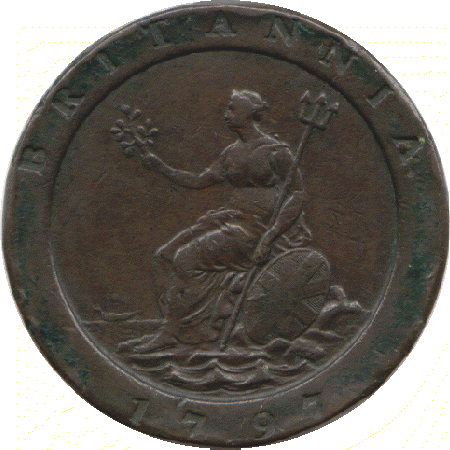
The new power source enabled 50 large 'cartwheels' or 150 smaller coins to be struck each minute. This marvellous feat employed the genius of two men: Matthew Boulton and his Soho Mint in Birmingham; and James Watt, the inventor of the steam engine. They had teamed eight coining presses to produce, for the time, huge amounts of coins in a short period of time.
Kegs containing about £650 worth arrived at Sydney in the first shipment, with smaller denominations coming the following year. The coins were dated 1797 and 1799 and all bore a rather unflattering portrait of George III on one side and Britannia on the reverse. The coins featured a wide rim with sunken lettering.
The somewhat unimpressive designs were a collaboration between Boulton himself and Heinrich Kuchler. The significance of the coins lies in the skills used in developing the steam coin press, not in the coin designs.
Boulton was obviously very proud of his product. He wanted his coins to double as weights and measures and for this reason his penny piece contained one full ounce of copper from the Welsh mines and the twopenny piece - two ounces of copper. No wonder they were nicknamed 'cartwheels'. Grocers thought it a good idea though, and used the coins when weighing out flour, and so forth. The twopenny piece could also be used to measure cloth: eight lined up end-to-end equalled one foot (30 centimetres). More of Boulton's pennies appeared in 1806 and 1807 and these coins were the staple diet for small transactions for many years.
The Rum Trade
From the departure of Captain Phillip at the end of his tenure as governor in 1792, until his official replacement by Captain Hunter in 1795, the infant colony was left in the care of lieutenant-governors - first Francis Grose, then William Paterson. Effectively, these two officers governed on behalf of, and in the personal interests of, the New South Wales Corps. They did not hesitate to take advantage of the situation presented to them.
Members of the New South Wales Corps had the ability to raise capital by borrowing against their regimental pay, which was accumulating back home in England. It was this facility which enabled the elite of the Corps to snatch control of trade in the colony and establish rum as the most common currency.
This happened in 1793 after the arrival of the American trading ship, the 'Hope', with 7,500 gallons of rum in her cargo. The other goods she carried were desperately needed but the Hope's incorrigible captain insisted that he would sell nothing to the colonists unless they first bought all of his rum. The New South Wales Corps officers saw this as an opportunity rather than a rort and formed a syndicate, with regimental paymaster John Macarthur at it's head, pulling the necassary financial strings.
They bought the cargo and distributed it at a huge profit. The vast pool of rum flooded into the market place at grossly inflated prices and at once became a means of exchange. For their efforts, the New South Wales Corps were immediately dubbed the 'Rum Corps', a name which stuck until their recall to England in 1810. The rich pickings they made from that first deal gave them the power to monopolise almost all trade, particularly that in rum (the name given to all spirits), for the next 17 years.
As rum grew to be the king of currency, the population of New South Wales soon became divided into two classes - those who dealt in rum and those who were paid with, and drank it. Rum, a liquid gold as the medium of exchange, was used and abused in more ways than one (hic..). Rum could buy anything. The wages for the construction of some of our most famous landmarks were paid out in rum. Rum was offered as a reward for the capture of bushrangers. The story goes that a man even sold his wife for four gallons of the stuff.
Many of the officers became publicans, with a very effective system set up to control their monopoly over rum. So openly brazen was the rum traffic that it was rumoured that even the chief constable held a liquor license and sold rum right opposite the gaol door. By 1806, rum had become far and away the major currency, and for rum the settlers mortgaged or sold their stock and their farms.
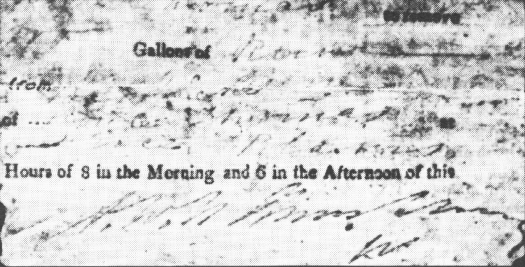
Shown at right is a Rum Authority/Order used around 1810 with the words:
Authorising Boyle Thomas to remove two gallons of rum from the house of Mr McGuire at the barracks to Boyle Thomas at Clarence Plains between the hours of 8 in the morning and 6 in the afternoon of this [...]
A well documented case connected with the rum trade was the construction of Sydney's (and Australia's) first hospital - more commonly known as the Rum Hospital. Built on the orders of Governor Macquarie between 1810 and 1816, the contract was let out to three entrepreneurs, D'Arcy Wentworth, Alexander Riley and Garnham Blaxcell in exchange for the rights to import 60,000 gallons of rum.
They used part of this rum to pay the wages of the hospital construction workers, and made a fortune in doing it. The consortium paid 10 shillings a gallon for the rum and then inflated the value to £2 17s 6d. Ironically, forty years later a part of this building would be converted to house the Sydney Mint for the production of official gold sovereigns and half sovereigns.
In another famous case, Macquarie paid for the building of a road between Sydney and Liverpool with 400 gallons of rum.
Manipulation of the value of Rum was not restricted to the cut and thrust of the business world. Inflating its value was considered to be fair play by those involved in undertaking 'God's work' when Australia's first church was built in 1793. The Reverend Richard Johnson paid out part of the workers' wages in rum he valued at 10 shillings per gallon but for which he had paid only 4s 6d a gallon.
The Rum Rebellion
William Bligh arrived at the colony in 1806 to take up the post of Governor. He was already well known to the colonists for his remarkable navigational feat in guiding a cutter full of castaways to Java after the infamous mutiny on the Bounty. Bligh knew that the power of the New South Wales Corps had broken his predessors, Hunter and King, and he fully intended to do the breaking this time. King had sent Macarthur to Britain to stand trial after he had nearly killed a colonel in a duel. Instead of any penalty, Macarthur returned deemed innocent and with a land grant of 5,000 acres.
Before Bligh committed himself to any dramatic reforms, he took time to understand the complex problems he had inherited. He quickly saw the worst effects of the rum currency. Agriculture, the life-blood that kept the colony from starvation, was severely depressed by the trade with farmers forced to accept 'payment in property', as rum was euphemistically known, for their wheat or other produce, at enormously inflated value. In turn, they used the rum to pay their workers. The rum traffic helped the elite New South Wales Corps maintain its power, while at the same time it debauched the quality of labour.
To overcome such anomalies, Bligh set about closing off the officer's sources of supply. He issued two general orders, one suppressing the rum trade by fixing the price, and the other making all promissory notes payable in cash, thus attempting to break the hold that the Rum Corps had over commerce. Macarthur openly defied the orders leaving Bligh with no choice but to respond by arresting Macarthur and sending him to trial on a number of charges ranging from illegal possession of a still to sedition and resisting arrest.
The Corps responded by staging what amounted to a coup d^etat on January 26, 1908, the 20th anniversary of the foundation of the colony. On that day a free settler, George Suttor recorded what he saw:
... the greater part of the New South Wales Corps under Arms with fixed bayonets, marching down from the Barrack. (I) hastened among others to know the cause; and was informed that they were going to arrest the Governor; and on proceeding a short way with them, distinctly heard Serjeant Major Whittle make use of these expressions - 'Men, I hope you will do your duty and don't spare them.' The men replied, 'Never fear us.'
Later, Major Whittle was heard to say, 'Children, go out of the way, for some of you I expect will be killed.' As events transpired, no one was actually killed. The Corps marched up Bridge Street to Government House, drums and all, and Governor Bligh was arrested, with some accounts claiming that he had to be ignominiously dragged out from under a bed. What followed the next day was reported later in the Sydney Morning Herald:
The day following was one of immense business. The Government was formally deposed, bonfires were lighted up at corners of almost every street, magistrates were dismissed, the Provost Marshal escorted to prison, the then sitting Criminal Court dissolved, troops were harangued ... the old Judge Advocate relieved of his offices ...
The commandant of the New South Wales Corps, Major George Johnston, released Macarthur from jail on a warrant which he signed illegally as 'lieutenant-governor' and with that, the Rum Corps took over the running of the colony for the next two years. And with the rule of the Rum Corps, so continued the rule of rum as money.
After a period of detention, Bligh was allowed to board his old ship, the Porpoise, upon which he commanded the captain to bombard the town. The captain refused, and Bligh sailed out of Sydney Harbour to exile in Van Diemen's Land (later Tasmania), to return only after the arrival of his official replacement, Governor Lachlan Macquarie, on New Years Day, 1810.
Lachlan Macquarie arrived in Sydney with instructions to end the rum trade, to send the New South Wales Corps home and to arrest the leaders of the rebellion - Macarthur and Johnston. Both, however, had sailed for England to put their own cases before the Government. Johnston was cashiered but Macarthur returned to New South Wales in 1814 with orders that he stay out of public affairs for the time being.
In the meantime, Macquarie began to tackle the major problems that he had inherited. The colony was nearly broke; what coins there were continued to be shipped away by visiting traders and the illicit rum trade ruled commerce. Unlike his predecessor King, Macquarie's tactics proved to be more successful. He recognised that barter in spirits was only part of a larger problem. An acceptable currency had to be established, for as long as there was a barter economy and private promissory notes passed at great discounts, wealth and power would inevitably remain in the hands of a few.
A stable currency would strengthen the economy and underpin its fragile political and social structure. Macquarie also realised that the dictatorial methods employed by Bligh, Hunter and King were useless against the well entrenched and now enormously wealthy proponents of the rum trade - some of whom were former Rum Corps members who had elected to stay in New South Wales as free settlers. Macquarie fixed on a plan that was both economically sound and a brilliant strategic move.
First, he reduced the number of licensed houses in Sydney from 75 to 20 and enforced their closure on Sundays. While he believed it essential to prevent the destructive use of liquor, he also realised it was impossible simply to ban it. He then moved to increase the supply of rum, making it less of a luxury and therefore devaluing it as a currency and discouraging monopolistic trade by a few. He did this by allowing the free importation of spirits, but with a relatively high duty of four shillings per gallon.
The Holey Dollar & Dump
Having dealt with one problem, Macquarie turned his attention to the task of finding a replacement for rum as a currency. In October of his first year in the colony, he suggested the founding of a bank. The idea was subsequently rejected. In the meantime, he asked for copper coin to stop the 'shameful' traffic in valueless notes. This too was rejected. Silver coins were not available from England because supplies had been depleted in repaying British debts from the Napoleonic wars.
Part of his salvation came in the guise of the sloop of war, the Samarang. Macquarie came up with a plan to purchase the most common silver coins in the trading world at that time - Spanish eight reale coins ('pieces of eight'). The Samarang arrived at Port Jackson in 1812 with 40,000 of these 'Spanish dollars' in her hold. Macquarie knew that to release the dollars as they were would only be a temporary solution, as these too would be traded out of the colony. He wrote:
Having decided it essentially necessary to adopt every possible precaution to prevent this Useful Supply of Dollars from being Exported, or Carried out of the Colony, I gave immediate Direction for Constructing a Machine here for the purpose of Stamping, Milling and Cutting a piece out of the Center of each Dollar, previous to my circulating this Specie in the Colony. Intending that each Dollar, and the small piece Cut out of the Center of each, should have the Value thereof, respectively, and the Name of the Colony stamped on it. The Value I determined on giving to the Dollar was Five Shillings Sterling, and fifteen pence to the small piece Cut out of the Center of each Dollar.
The strategy of mutilating each coin, which had been used in various other countries at that time, effectively caused traders to spurn it. Macquarie's master stroke had created two coins out of one. The outer ring which he called the Colonial dollar had a new value of five shillings. The inner portion, called the Dump, was valued at fifteen pence.
Macquarie's initiative dramatically increased the number of coins in circulation and distinguished them as local currency, therefore deterring their removal from the colony on departing trading ships. Not only did the coins solve the immediate currency problem, but Macquarie also made a substantial profit in the process. He had paid four shillings and nine pence for each silver dollar, but the new face values totalled six shillings and three pence.
To create the first truly indigenous Australian coin, Macquarie employed the services of William Henshall (or Hershall) to cut and restrike the coins. A recently freed convict, Henshall had the right credentials for the job - coming from Birmingham, England's centre of illicit coining where he worked as a cutler, whitesmith (worker in white metals) and silversmith, he had been sentenced to transportation for forging coins.He had completed the seven-year sentence only the previous year.
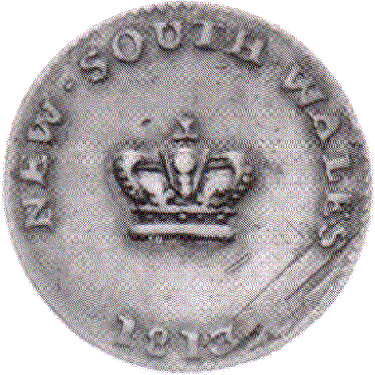
The Dump was about the size of our modern 5 cent piece and was re-struck after being cut from the dollar. A crown surrounded by the words 'New South Wales' and the date '1813' appear on one side with the words 'Fifteen pence' across the centre of the other side. The dump is slightly larger than the hole from which it came due to the spread of metal during re-striking.
The Colonial, or Holey dollar as it became better known, was overstamped around the inner rim. One side bore the words 'New South Wales' and the date '1813' while the other side displayed a spray of leaves and the wording 'Five Shillings'. A number of dies were produced and the initial 'H' for Henshall appears on some of them.
Almost all dollars used in the series bore the legend Carolus III, Carolus IIII or Ferdinand VII.
They carried various mintmarks and dates between 1757 and 1810. Most are of South American origin, where the Spanish mined huge amounts of silver for hundreds of years. Mintmarks of the major mints are the M and small circle of the Mexico City Mint, the PTS for Potosi, Bolivia and the LIMAE of Lima, Peru.
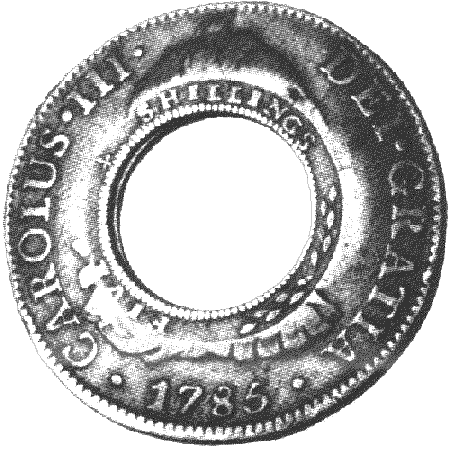
An interesting sidelight concerns the reverse of the coin which shows the pillars of Hercules (the Straits of Gibraltar) which have a ribbon woven around them. The 'S' swirl of the ribbon through the pillars is still seen in the modern-day version of our dollar sign - $.
Macquarie's new currency and rum policy, in combination with a number of other factors - the expansion of the settlement, the growth of businesses other than farming and the growing number of free settlers and emancipists - turned the tide against the rum standard. He broke effectively broke the exploitative system and introduced into colonial life his own evenhanded attitudes towards convicts. Setting the scene for social development in Australia, Macquarie fostered reform and emancipation amongst convicts, recognising that by the sheer force of their numbers, they and their descendants held the key to the future.
The Dollar Experiment
The benefits of Macquarie's holey dollar to the New South Wales economy would have been even greater, had they not been hoarded. By 1820, the Bank of New South Wales reported that it held 16,680 holey dollars and 5,900 dumps.
Even so, Holey Dollars and Dumps continued as the most common coinage used in the colony until 1823, when Governor Brisbane issued a number of proclamations in an attempt to establish a Dollar standard. He recalled the coins and fixed the Spanish Dollar as equivalent to Five Shillings. The holey dollar and dump were marked down to four shillings and one shilling respectively, and then re-issued.
Brisbane was nearly 150 years ahead of his time when he tried to make the dollar the major unit of currency in New South Wales. From 1823 to 1826 all official script and bank issues were given in dollars. The system was soon undermined when substantial numbers of uncut Spanich dollars found their way to the colony as traders found it profitable to buy the coins overseas for around 4/4 each and sell them 5/-.
The experiment was short lived. The English Parliament passed the Sterling Silver Money Act in 1826 which officially ended the dollar standard. The conversion back to the sterling standard created severe problems for the fledgling Bank of New South Wales. Were it not for Government backing of it's note issues, it is doubtful that the Bank would have survived.
Official English Coinage
The tide turned back in favour of the English denoninations with the importation of nearly £100,000 worth of English coins in 1824 and 1825. On 7th August, 1829, Governor Darling issued a General Order where, on 30th September, 1829, the status of legal tender would be dropped from the Holey dollar and the Dump. Most were immediately swapped for circulating English silver coins. Although they continued to circulate in Tasmania until 1849, few have survived until today.
It is estimated that only about 350 Holey dollars (296 are known) and about 1,500 Dumps remain. Their scarcity and historic merit make them a well deserved Australian rarity. The Holey dollar and its smaller counterpart, the Dump, are now among the most prized of the early colonial issues.
Darling's proclamation also directed that Government transactions would not be conducted with foreign coins - English coinage was officially the preferred medium of exchange. From the mid 1830's until the introduction of Australia's Commonwealth coins in 1910 is regarded as a sort of 'Dark Ages' period to most collectors of Australia's official coinage. Apart from the token issues and the series of gold coins of the era, little interest is taken in the official English issues, even though it was a period of immense interest and innovation.
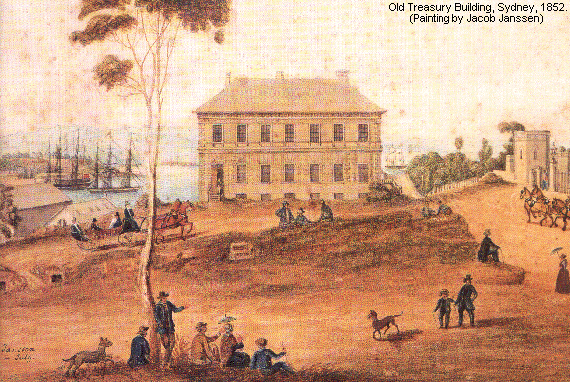
For eighty-five years, Australia received all of its silver and official copper issues from England. British sovereigns and half sovereigns also mingled with the home product. A steady flow of coins had come to the colony following the establishment in 1810-12 of the new London mint on Tower Hill, fitted with Boulton-Watt steam powered presses.
It was during this period that the famous St. George and the Dragon sovereign first appeared; and when the Godless florin was struck. It was also a time when designers were criticised for such designs as that of the jubilee of Queen Victoria, which made the stern looking monarch appear comical under a tiny crown that seemed about to topple off.
Other design errors of the time caused far more serious consequences. The reverse design of the jubilee sixpence closely resembled the shield reverse sovereign. Soon gilt-dipped sixpences were being passed for their golden counterparts. Bright shiny farthings were also passed or mistaken for half sovereigns and from 1897, the surfaces were deliberately darkened before issue to arrest this problem.
But of all the changes, the one which took place in 1860 is probably the most important. The heavy 'cartwheel' copper coins of the early colonial days were replaced by lighter denominations made from bronze. The alloy was one devised in France for the making of church bells and contained copper, zinc and tin. This metal combination and the size of the coins were to be adopted in the Australian issue of 1911.
In April, 1864, the Sydney Times reported:
The efforts made during the last eighteen months or two years to call in the old copper coins and issue their bronze substitutes have, it appears, been successful to a great extent, so far at least as the large towns are concerned. We understand that old pence, half-pence anf farthings to the nominal value of about £400,000 have been returned to the Master of the Mint and replaced. The full amount of the old copper coins in circulation is supposed to have been about £750,000. Vigorous efforts are now being made to get in the residue from villages, hamlets and the more remote districts of the country.
The notion that the old pennies of the reign of George III, known as the rim pennies, were more valuable than the ordinary ones, is we are informed, quite erroneous, as the intrinsic value is now little more than half the nominal or circulating price, and nothing like the quantity of coins can be used by the Mint in the new issue. The rim pennies were originally 16 pieces to the pound. Reduced by friction, they now run about 18 to the pound. In the course of a short time, the tender of the old coins will be declared illegal, and can only be taken at the price of old copper, which is now about 11d per pound.
Traders Tokens
Traders tokens were unofficial coin-like issues struck by a variety of merchants to overcome a severe small-change shortage of English coins caused largely by the population explosion which occurred during the gold rushes of the early 1850's. The majority of the tokens were issued between 1855 and 1865. Prior to this, many merchants who had been hampered in their trading by the shortage, were often forced to pay a premium for whatever change they could get.
As well as being a convenient means of exchange, the tokens were also an excellent vehicle for advertising particular businesses and products. Everyone from doctors to ironmongers issued tokens and although the authorities frowned on the practice to some degree, a blind eye was turned due to the serious needs of the time.
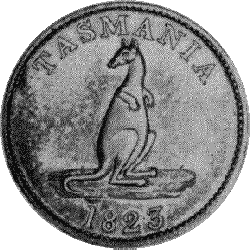
Although not the rarest, the most sought-after token is the Macintosh and Degraves one shilling silver piece which was issued in Tasmania. Dated 1823, it is believed to be the earliest Australian token. Another interesting feature is that the token contains the word 'Tasmania' as part of its legend. Officially the island was known as Van Diemen's Land until 1856.
Silver threepenny tokens were later issued in New South Wales by three different firms. J.C. Thornwaite of Sydney issued a number of undated tokens as well as some bearing the date 1854. A general merchant from Morpeth (near Maitland) named James Campbell issued an undated threepence while similar denominations dated 1858 and 1860 were struck by Hogarth, Erichsen and Co. of Sydney. Such silver issues are unusual as most tokens were of copper or bronze for values of either a penny or halfpenny.
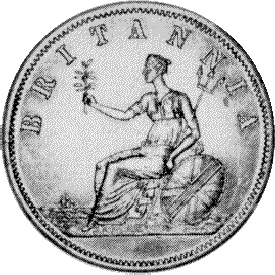
The first of the penny tokens were issued by Annand, Smith and Co., family grocers, in 1849. By 1862, a monster had been created with so many varieties of tokens circulating that they had become more of a nuisance than a help. Victoria was the first to act by making the tokens illegal in 1863. New South Wales was to follow suit but not before some smart-thinking businessmen had made a small fortune. When Victoria outlawed the tokens, speculators bought up the penny tokens at sixpence a dozen and dumped them in other colonies to make a quick 100% profit.
By 1868, a large shipment of regal coins from Britain had cured the small-change problem and a short but colourful chapter in our history faded from view.
Thomas Stokes, who arrived in Melbourne about 1854, was responsible for the production of more tokens than any other maker. In 1857, he acquired the plant Taylor had prepared for the 'Kangaroo Office' and which failed to get started. It is difficult, if not impossible, to determine what is the work of Taylor and what is the work of Stokes with dies prepared by Taylor. Dies bearing Stokes' name commence in 1862, but in the next year tokens were declared illegal in Victoria.
Production continued for issuers in other Colonies, and Stokes produced the majority of tokens used in New Zealand where they were issued until 1881. Thomas Stokes died in 1910.
Many of Stokes token dies survive, which has proved to be a mixed blessing as there have been many re-strikes from them up until 1964, in both old and new combinations. Some of the dies are in the hands of Stokes (Australasia) Ltd, in Melbourne and others have been presented to Museums. The exact numbers and locations of all dies is unknown.
Colonial Banknotes
Coverage of Australia's early currency would be incomplete without a reference to the banknotes issued by private banks. The Bank of New South Wales, Australia's first public company, was founded in 1817. The scheme to create the bank was undertaken by Governor Lachlan Macquarie and a group of wealthy colonial businessmen.

The formation of the new bank reflected the confidence of the private businessmen in the future of the colony. It was to be the first of many such public investments. By 1850, the colony had a fully fledged currency system with over thirty banks providing the cornerstone for a rapidly increasing volume of commerce.
The issue of private banknotes from 1817 was one of the most important financial feats in Australia's history, paving the way for the economic growth and prosperity which followed. During the course of the next 90 years, a wide variety of banknotes were issued. Many banks did not survive the 'boom and bust' nature of the times while others, through mergers, name changes and takeovers, exist in the three major banking groups of today - ANZ, NAB and Westpac.
Many banks, with wealth invested from overseas, made the largest contribution to the fledgling economy, providing a large proportion of the capital needed for the pastoral expansion which occurred from the 1830's onwards.



